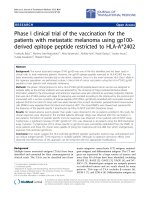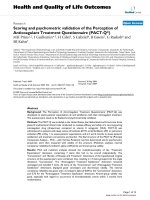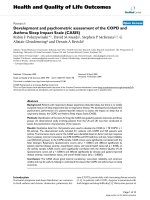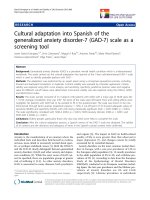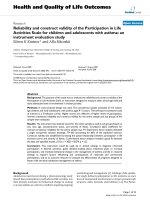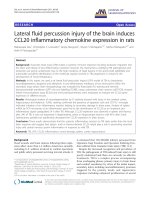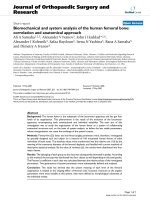báo cáo hóa học:" Intramedullary versus extramedullary alignment of the tibial component in the Triathlon knee" potx
Bạn đang xem bản rút gọn của tài liệu. Xem và tải ngay bản đầy đủ của tài liệu tại đây (358.55 KB, 4 trang )
RESEARC H ARTIC L E Open Access
Intramedullary versus extramedullary alignment
of the tibial component in the Triathlon knee
James P Cashman
1*
, Fiona L Carty
2
, Keith Synnott
1
and Paddy J Kenny
1
Abstract
Background: Long term survivorship in total knee arthroplasty is significantly dependant on prosthesis alignment.
Our aim was determine which alignment guide was more accurate in positioning of the tibial component in total
knee ar throplasty. We also aimed to assess whether there was any difference in short term patient outcome.
Method: A comparison of intramedullary versus extramedullary alignment jig was performed. Radiological
alignment of tibial components and patient outcomes of 103 Triathlon total knee arthroplasties were analysed.
Results: Use of the intramedullary was found to be significantly more accurate in determining coronal alignment
(p = 0.02) while use of the extramedullary jig was found to give more accurate results in sagittal alignment (p =
0.04). There was no significant difference in WOMAC or SF-36 at six months.
Conclusion: Use of an intramedullary jig is preferable for positioning of the tibial component using this knee
system.
Introduction
Long term survivorship in total knee arthroplasty is sig-
nificantly dependant on prosthesis alignment. Several
studies have correlated poor o utcome with malalign-
ment of the components [1]. Accuracy of component
positioning relies on alignment guides for making pre-
cise and accurate bone cuts. Bargren et all reported a
91% failure rate for TKAs with varus tibio-femoral align-
ment and 11% of valgus alignment [2]. Significant con-
tention still exists as to what the optimal alignment
guide for placement of the tibial component is. While
most patients are suitable for the use of either alignment
system, patients with a largesofttissueenvelopecan
preclude the use of an extramedullary guide while tibial
deformity, previous fracture or retained metalwork can
prevent use of an intramedullary guide.
Our aim was determine which alignment guide was
more accurate in positioning of the tibial component in
total knee arthroplasty. We also aimed to assess whether
there was any difference in short term patient outcome.
Materials & methods
We identified 103 consecutive total knee arthroplast ies
(TKA) in 95 patients which were performed between
January 2008 and October 2008 by four Orthopaedic
surgeons. The underlying diagnosis in all cases was pri-
mary osteoarthritis. There were no cases of tibial defor-
mity precluding the use of an intramedullary jig. All
patients underwent cemented total knee arthroplasty
using the Tria thlon knee system [Stryker, Kalamazoo,
MI, USA]. The majority of patients (85 knees) had a
posterior stabilised prosthesis with the re mainder having
a cruciate retaining design. This was performed under
spinal anaesthesia using a n above knee tourniquet. A
medial parapatellar approach was used in all cases.
Femoral alignment was determined using an intramedul-
lary jig. In determining tibial alignment , an extramedul-
lary or intramedullary alignment jig according to
surgeon preferenc e. If an extramedullary jig was used, a
tibial cutting block with a posterior slope of 3° was used
whereas if an intramedullary jig was used, the posterior
slope was set at 0°. All patients were rehabilitated
according to a standardised protocol.
Informed consent was obtained from all patients preo-
peratively to o btain data for the Cappagh National
Orthopaedic hospital joint registry. Demographic data
including age, gender and BMI was captured
* Correspondence:
1
Department of Orthopaedics, Cappagh National Orthopaedic Hospital,
Finglas, Dublin 13, Ireland
Full list of author information is available at the end of the article
Cashman et al. Journal of Orthopaedic Surgery and Research 2011, 6:44
/>© 2011 Cashman et al; licensee Bio Med Central Ltd. This is an Open Access article distributed under the terms of the Creative
Commons Attr ibution License (http ://creativecommons.org/licenses/by/2.0 ), which permits unrestricted use, distribution, and
reproduction in any medium, provided the original work is properly cited.
preoperatively. Operative details were captured at time
of surgery. The WOMAC score was used as disease spe-
cific outcome score and the SF-36 was used as a general
health outcome measure. These were captured preo-
peratively and at 6 months.
All patients had an AP and Lateral standing knee
radiogra ph performed at 6 months. Coronal and Sagittal
ali gnment of the tibial components were determined by
an assessor blinded to which alignment jig was used
intraoperatively. Three measurements were performed
and a mean value for alignment was determined. Axis
was measured in terms of deviation from the mechanical
axis of the tibia.
Patient outcome data was captured using Bluespiers
[Worcestershire, UK] clinical software. Information was
collated using Microsoft Excel and statistical analysis
was performed using Minitab statistical software http://
www.minitab.com. A p value > 0.05 was taken as statis-
tical significance.
Results
There were 103 TKAs in total. In 36 cases, an intrame-
dullary jig was used. There was no statistical difference
between the t wo groups in terms of age, gende r, body
mass index (BMI) or length of inpatient hospital stay
(LOS) [Table 1]. There were no complications asso-
ciated with the use of an intramedullary jig.
The mean coronal alignment of the tibial components
in the intramedullary group was 1.6° from the mechani -
cal axis and the mean coronal alignment in the extrame-
dullary group was 2.4° [Table 2]. This was a statistically
significant difference (p = 0.02). All patients in the intra-
medullary group were within two standard deviations of
the mean alignment, while in the extramedullary group
there were a number of outliers [Figure 1].
The mean sagittal alignment of the tibial components
in the intramedullary group was 3.4° from the mechani -
cal axis and the mean sagittal alignment in the extrame-
dullary group was 4.5°. This difference was not
statistically different (p = 0.07). There were more out-
liers in t he extramedullary group [Figure 2]. When the
sagittal alignment measurement was corrected for the
cutting jig used, the extramedullary jig was found to be
within 1.5° of the intended 3° cut. This was significantly
more accurate than the intramedullary jig (p = 0.04).
WOMAC and SF-36 scores were determined preo-
peratively and postoperatively [Table 3]. There was no
significant d ifference in the preoperative WOMAC and
SF-36 scores between the two groups. Postoperatively,
theWOMACscoreintheintramedullarygroup
improved by 11.8 and the SF-36 by 12.7 while the
improvement in the extramedullary group was 22.5 in
both scores. This difference, however, did not reach sig-
nificance (p = 0.06).
Discussion
Thi s study exam ined the tibial component alignment in
similar groups of patients, in terms of patient demo-
grap hics, who were treated by a group of four surgeons.
The intramedullary guide was found to be more reliable
for determin ing coronal alignment. Use of the extrame-
dullary guide seemed to more reliably cut the desired
posterior slope but the difference was only one degree.
Regardless of which alignment jig was used, this did not
seem to influence patient outcome.
Component alignment has been shown to have a bear-
ing on patient outcome parameters. When analysing
alignment parameters such as sagittal femoral, coronal
femoral, rotational femoral, sagittal tibial, coronal tibial
and femuro-tibial mismatch, this group found that when
the number of alignment errors were reduced that the
short term patient outcomes were significantly improved
Table 1 Patient Demographics
Intra-medullary Extra-medullary
Total TKA 36 67
Mean age 68.9 68.9
% male 21% 34%
Mean BMI 31.9 31.6
Mean LOS 10.5 9.1
Table 2 Tibial Component Alignment
Coronal Alignment p =
Intramedullary 1.6 0.02
Extramedullary 2.4
Sagittal Alignment
Intramedullary 3.4 0.07
Extramedullary 4.5
Sagittal Corrected
Intramedullary 3.1 0.04
Extramedullary 1.5
Figure 1 Coronal Alignment.
Cashman et al. Journal of Orthopaedic Surgery and Research 2011, 6:44
/>Page 2 of 4
[3]. Use of the intramedullary jig seems to reduce the
chance of outliers. This is o ne of the proposed benef its
of navigated TKA [4]. However, computer navigated
total knee arthroplasty has been found not to be a cost
effective investment in terms of reducing revision risk in
TKA [5].
A study of British orthopaedic surgeons found that
75.6% prefer extramedullary and 20.3% prefer intrame-
dullary jigs when determining tibial alignment with the
remainder using both or neither [6]. The published litera-
ture is divided as to which jig is superior. Rottman et al
found no difference in alignment between intra- and
extramedullary alignment i n TKA in a retrospective ser-
ies of 55 patient s [7]. Reed et al performed a randomised
prospective trial which showed that intramedullary
guides were superior to extramedullary guides in deter-
mining coronal alignment of the tibial component [8]. In
this study, we also found that the intramedullary guide
was more reliable in determining coronal alignment. The
mean deviation from the mechanical axis was 1.6 degrees
with this jig but more importantly, there were no outliers.
There are relative indications for each method of align-
ment determination. Lozano et al examined obese patients
and found no difference in the alignment of the tibial
component between intra and extramedullary guides.
However, there was a reduced tourniquet time associated
with the intramedullary guide [9]. However, transesopha-
geal echocardiography during the course of conventional
intramedullary instrumented total knee procedures has
demonstrated showers of fat or intramedullary embolic
particles enter the right atrium of the heart in repeated
and unpredictable patterns [10]. Most often these are
clinically unimportant. Patients with significant extra-
articular deformities, marked bowing, and those with prior
surgery or fractures may not be suitable for intramedullary
guides, and they may require the use of extramedullary
guides and intra-operative radiographic control [11].
Conclusions
This study has shown that use of an intramedullary
alignment jig is more accurate in positioning the tibial
component in TKA in terms of coronal alignment. Use
of the extramedullary jig was found to be more accurate
in terms of sagittal alignment. There was no significant
difference in short term patient outcome scores. We
would advocate the use of the intramedullary alignment
jig to optimise tibial component positioning.
Author details
1
Department of Orthopaedics, Cappagh National Orthopaedic Hospital,
Finglas, Dublin 13, Ireland.
2
Department of Radiology, Cappagh National
Orthopaedic Hospital, Finglas, Dublin 13, Ireland.
Authors’ contributions
JC participated in the design of the study and performed the statistical
analysis. FC collected the study data and edited the manscript. KS and PK
contributed to the study design and drafted the manuscript. All authors
read and approved the final manuscript.
Competing interests
The authors declare that they have no competing interests.
Received: 1 November 2010 Accepted: 20 August 2011
Published: 20 August 2011
References
1. Lotke PA, Ecker ML: Influence of positioning of prosthesis in total knee
replacement. J Bone Joint Surg Am 1977, 59(1):77-79.
2. Bargren JH, Blaha JD, Freeman MA: Alignment in total knee arthroplasty.
Correlated biomechanical and clinical observations. Clin Orthop Relat Res
1983, , 173: 178-183.
3. Longstaff LM, Sloan K, Stamp N, Scaddan M, Beaver R: Good alignment
after total knee arthroplasty leads to faster rehabilitation and better
function. J Arthroplasty 2009, 24(4):570-578.
4. Lutzner J, Krummenauer F, Wolf C, Gunther KP, Kirschner S: Computer-
assisted and conventional total knee replacement: a comparative,
prospective, randomised study with radiological and CT evaluation. J
Bone Joint Surg Br 2008, 90(8):1039-1044.
5. Slover JD, Tosteson AN, Bozic KJ, Rubash HE, Malchau H: Impact of hospital
volume on the economic value of computer navigation for total knee
replacement. J Bone Joint Surg Am 2008, 90(7):1492-1500.
6. Phillips AM, Goddard NJ, Tomlinson JE: Current techniques in total knee
replacement: results of a national survey. Ann R Coll Surg Engl 1996,
78(6):515-520.
7. Rottman SJ, Dvorkin M, Gold D: Extramedullary versus intramedullary
tibial alignment guides for total knee arthroplasty. Orthopedics 2005,
28(12):1445-1448.
8. Reed MR, Bliss W, Sher JL, Emmerson KP, Jones SM, Partington PF:
Extramedullary or intramedullary tibial alignment guides: a randomised,
prospective trial of radiological alignment. J Bone Joint Surg Br 2002,
84(6):858-860.
9. Lozano LM, Segur JM, Macule F, Nunez M, Torner P, Castillo F, Suso S:
Intramedullary versus extramedullary tibial cutting guide in severely
Figure 2 Sagittal Alignment.
Table 3 Patient Outcome Scores
Intra-medullary Extra-medullary p =
Pre WOMAC 43.2 45.9 0.6
6 mnth WOMAC 31.4 23.4 0.06
Change 11.8 22.5
Pre SF-36 39.4 39.2 0.9
6 mnth SF-36 52.1 61.7 0.06
Change -12.7 -22.5
Cashman et al. Journal of Orthopaedic Surgery and Research 2011, 6:44
/>Page 3 of 4
obese patients undergoing total knee replacement: a randomized study
of 70 patients with body mass index > 35 kg/m2. Obes Surg 2008,
18(12):1599-1604.
10. Caillouette JT, Anzel SH: Fat embolism syndrome following the
intramedullary alignment guide in total knee arthroplasty. Clin Orthop
Relat Res 1990, , 251: 198-199.
11. Maestro A, Harwin SF, Sandoval MG, Vaquero DH, Murcia A: Influence of
intramedullary versus extramedullary alignment guides on final total
knee arthroplasty component position: a radiographic analysis. J
Arthroplasty 1998, 13(5):552-558.
doi:10.1186/1749-799X-6-44
Cite this article as: Cashman et al.: Intramedullary versus extramedullary
alignment of the tibial component in the Triathlon knee. Journal of
Orthopaedic Surgery and Research 2011 6:44.
Submit your next manuscript to BioMed Central
and take full advantage of:
• Convenient online submission
• Thorough peer review
• No space constraints or color figure charges
• Immediate publication on acceptance
• Inclusion in PubMed, CAS, Scopus and Google Scholar
• Research which is freely available for redistribution
Submit your manuscript at
www.biomedcentral.com/submit
Cashman et al. Journal of Orthopaedic Surgery and Research 2011, 6:44
/>Page 4 of 4

